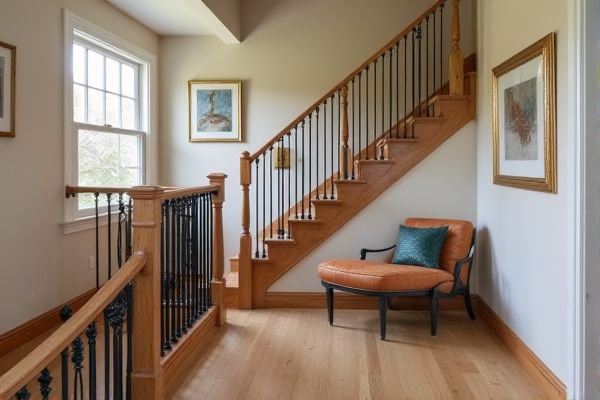
Wooden spindles offer a classic, warm aesthetic and are often preferred for traditional or rustic designs, while metal spindles provide a sleek, modern look with greater durability and low maintenance. Discover which spindle type best suits Your style and functional needs by exploring the detailed comparison in the rest of the article.
Table of Comparison
| Feature | Wooden Spindles | Metal Spindles |
|---|---|---|
| Material | Natural wood (oak, maple, pine) | Steel, aluminum, iron |
| Durability | Moderate; prone to wear, rot, and insects | High; resistant to corrosion and impact |
| Maintenance | Requires refinishing and sealing periodically | Low maintenance; may require rust prevention |
| Appearance | Warm, classic, customizable with stain or paint | Modern, sleek, available in various finishes |
| Weight | Lighter | Heavier and stronger |
| Cost | Generally lower initial cost | Higher upfront cost, offset by durability |
| Installation | Easy to cut and shape on-site | May require special tools and welding |
| Environmental Impact | Renewable, biodegradable | Non-renewable, recyclable depending on metal |
| Use Cases | Residential staircases, decorative railings | Commercial buildings, high-traffic areas |
Introduction to Wooden and Metal Spindles
Wooden spindles offer a classic, warm aesthetic popular in traditional and rustic designs, known for their natural texture and easy customization through staining or painting. Metal spindles provide superior strength and durability, often used in modern or industrial styles, featuring sleek finishes like wrought iron or stainless steel that resist wear and corrosion. Your choice between wooden and metal spindles impacts both the visual appeal and structural performance of staircases and furniture.
Material Composition and Aesthetics
Wooden spindles, crafted from hardwoods like oak or maple, offer natural warmth and classic charm ideal for traditional or rustic settings, while metal spindles, usually made from wrought iron or steel, provide modern durability and sleek, industrial aesthetics. The material composition influences not only the visual appeal but also the finish options, with wood allowing for staining and painting to enhance grain patterns, and metal offering powder coating for color variety and rust resistance. Your choice between these spindle types impacts both the tactile experience and the overall design harmony of staircases or railings.
Durability and Longevity Comparison
Wooden spindles offer a classic aesthetic but tend to be less durable than metal spindles, especially in high-traffic or outdoor settings where moisture and pests can cause deterioration. Metal spindles, often made from steel or aluminum, provide superior longevity due to their resistance to rust, warping, and cracking, making them ideal for both interior and exterior use. Your choice between wooden and metal spindles should consider the expected wear and environmental conditions to ensure the best durability and lifespan.
Maintenance Requirements for Each Type
Wooden spindles require regular sealing or painting to prevent moisture damage, cracking, and fading, while metal spindles primarily need rust prevention treatments such as periodic painting or powder coating. Maintenance of wooden spindles may include sanding and refinishing to preserve their aesthetic and structural integrity, whereas metal spindles typically involve inspecting for corrosion and treating any affected areas promptly. Both materials benefit from routine cleaning, but wooden spindles demand more frequent upkeep to maintain durability in outdoor environments.
Cost Analysis: Wooden vs Metal Spindles
Wooden spindles generally offer a lower initial cost compared to metal spindles, making them a budget-friendly option for many homeowners. However, metal spindles tend to have higher durability and require less maintenance over time, potentially reducing long-term expenses. Your choice should balance upfront investment with the expected lifespan and upkeep costs to find the most cost-effective solution for your stair or railing project.
Design Versatility and Customization
Wooden spindles offer superior design versatility with intricate carvings and a wide range of stains and finishes that can be tailored to match any architectural style. Metal spindles provide customization through sleek, modern designs and powder-coated finishes in various colors, perfect for contemporary aesthetics. Your choice depends on whether you prioritize traditional craftsmanship or modern durability in your railing design.
Safety and Structural Integrity Factors
Wooden spindles offer natural flexibility and aesthetic warmth but may weaken over time due to moisture exposure and insect damage, potentially compromising safety and structural integrity. Metal spindles provide superior strength, durability, and resistance to environmental factors, ensuring long-lasting support and enhanced safety for your railing systems. Choosing the right material depends on balancing your design preferences with maintenance considerations and regulatory load requirements.
Installation Process and Complexity
Wooden spindles typically require more precise measurements and careful handling during installation due to their susceptibility to warping and splitting, making the process moderately complex. Metal spindles offer a more straightforward installation with pre-drilled holes and a standardized fit, reducing the time and skill needed for assembly. Your choice between wooden and metal spindles will impact the ease of installation and the tools required.
Environmental Impact and Sustainability
Wooden spindles offer a renewable and biodegradable option, often sourced from sustainably managed forests, reducing carbon footprint compared to metal counterparts. Metal spindles, typically made from steel or aluminum, involve energy-intensive extraction and processing, contributing to higher greenhouse gas emissions. However, metal spindles can be recycled multiple times without degradation, promoting long-term material reuse and circular economy benefits.
Choosing the Right Spindle for Your Project
Wooden spindles offer a classic, warm aesthetic ideal for traditional and rustic designs, providing easy customization through staining or carving. Metal spindles, typically made from steel or aluminum, deliver superior durability and a sleek, modern look suitable for contemporary projects and outdoor use. Selecting the right spindle depends on factors such as design style, environmental exposure, budget considerations, and maintenance preferences.
 homyna.com
homyna.com